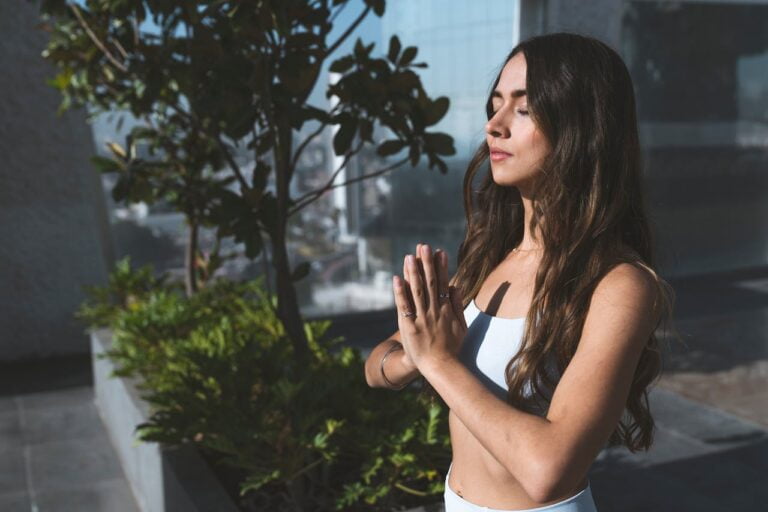Yoga meditation

By Temple of Umi

Table of Contents
Discover how to seamlessly integrate yoga meditation principles into your daily life, enhancing wellness through mindful diet, exercise, and sleep. Learn the keys to a sustainable yoga meditation routine for lasting harmony and balance.
Introduction
Yoga meditation, a practice deeply rooted in ancient traditions, connects the body, mind, and spirit through a blend of physical postures, controlled breathing, and the calming of the mind. Originating thousands of years ago, yoga meditation is a cornerstone of Eastern spiritual practices, with its historical roots tracing back to the Vedic texts of India. These ancient manuscripts lauded meditation as a pivotal method for achieving spiritual enlightenment and self-realization.
In modern life, the significance of yoga meditation has transcended cultural and geographical boundaries, becoming a universally embraced tool for enhancing overall well-being. Amidst contemporary society’s fast-paced and often stressful environment, yoga meditation offers a sanctuary for individuals to retreat to, providing profound benefits such as stress reduction, improved mental clarity, and a greater sense of peace and well-being. It’s a practice and a holistic approach to living, encouraging a harmonious balance between physical health and mental tranquility.
The Basics of Yoga Meditation
Understanding Yoga Meditation: Definition and Key Concepts
At its core, yoga meditation is the practice of focusing the mind and cultivating a state of deep peace and awareness. Unlike the common misconception that yoga only involves physical postures, yoga meditation encompasses a broader spectrum, including Pranayama (breath control), dhyana (concentration), and samadhi (a state of profound meditation). The essence lies in harmonizing the body’s movements with mindful breathing and mental focus, guiding practitioners toward inner tranquility and self-awareness.
Different Types of Yoga Meditation Techniques
- Mantra Meditation: Utilizing repetitive sounds to clear the mind, such as the well-known “Om.”
- Transcendental Meditation: A technique for detaching from anxiety and promoting harmony and self-realization through silently repeating a mantra.
- Chakra Meditation: Focuses on the body’s seven chakras or energy centers, using visualization and breath control to harmonize and balance energy.
- Mindfulness Meditation: Emphasizes present-moment awareness, observing thoughts and feelings without judgment.
Preparing for Yoga Meditation: Setting, Posture, and Mindset
- Setting: Choose a quiet, comfortable space where you won’t be disturbed. To create a calming atmosphere, you may enhance the environment with dim lighting, candles, or incense.
- Posture: Sit on a cushion or chair with a straight back but not stiff. Hands can rest gently on your knees or lap. Ensure your comfort, as physical discomfort can distract from meditation.
- Mindset: Approach your practice with an open, patient attitude. Acknowledge that distraction is a natural part of the learning process and gently refocus as needed.
Embarking on the journey of yoga meditation requires no special equipment or elaborate setup. With consistency and patience, practitioners can unlock this ancient practice’s profound benefits, fostering a sense of serenity and connectedness in their daily lives. Learn more.

Benefits of Yoga Meditation
Yoga meditation is more than just a practice; it’s a transformative journey that enhances every facet of your life, from mental clarity to physical vitality and spiritual depth. Let’s delve into the myriad benefits this ancient discipline offers.
Enhancing Mental Health
- Stress Relief: Yoga meditation is a powerful antidote to the pressures of modern living. By focusing on the present moment and breathing deeply, you can achieve a state of calmness, reducing cortisol levels and alleviating stress.
- Anxiety Reduction: Regular practice helps in managing and reducing anxiety by calming the mind and body, promoting a sense of peace and relaxation.
- Emotional Well-being: It encourages a positive outlook on life, boosts mood, and enhances overall emotional resilience, helping you navigate life’s ups and downs more easily.
Physical Health Improvements
- Increased Flexibility: Yoga meditation involves postures and stretches that enhance flexibility, reducing the risk of injuries.
- Strength: Many yoga poses require you to support your body weight in new ways, including balancing one leg or supporting yourself with your arms, gradually building strength.
- Improved Posture: Regular practice strengthens the core and helps you maintain a naturally upright posture, alleviating back pain and enhancing breathing capacity.
Spiritual Benefits
- Enhanced Mindfulness: Yoga meditation cultivates an awareness of the present moment, encouraging a deeper connection with your inner self.
- Spiritual Awakening: For those on a spiritual quest, yoga meditation can be a path to enlightenment, offering insights into the nature of existence and our place in the universe. Learn more.
How to Start Yoga Meditation: A Beginner’s Guide
Embarking on your yoga meditation journey might seem daunting at first, but with the right approach, it can become an enriching part of your daily routine. Here’s how to get started:
Choosing the Right Type of Yoga Meditation for You
- Explore different styles, from Vinyasa‘s physicality to Hatha‘s tranquility, to find the one that resonates with you.
- When selecting a practice, consider your physical condition, preferences, and spiritual goals.
Step-by-Step Instructions for Basic Yoga Meditation Techniques
Find a Quiet Space: Choose a peaceful spot where you won’t be disturbed.
Settle into a Comfortable Position: Sit cross-legged on the floor or a chair with your feet flat. Keep your spine straight and hands resting on your knees or lap.
Close Your Eyes and Focus on Your Breath: Take deep, slow breaths. Inhale through your nose, filling your lungs, then exhale slowly. Feel each breath energizing your body.
Clear Your Mind: As you focus on your breath, allow thoughts to come and go without attachment. Return your focus to your breath whenever you notice your mind wandering.
Tips for Incorporating Yoga Meditation into Your Daily Routine
- Set a Specific Time: Whether morning or evening, dedicating a specific time for meditation helps build a consistent practice.
- Start Small: Begin with just a few minutes each day and gradually increase the duration as you become more comfortable.
- Create a Dedicated Space: Having a particular spot for your practice can enhance your focus and make your practice more meaningful. Learn more. Learn more.
Overcoming Common Challenges in Yoga Meditation
Yoga meditation offers a pathway to inner peace and mindfulness, yet embarking on this journey comes with challenges. By understanding and addressing these hurdles, practitioners can enhance their meditation experience and reap more significant benefits.
Dealing with Distractions and Maintaining Focus
Distractions are a common obstacle in yoga meditation, stemming from external noise and internal thoughts. Overcoming these distractions begins with the following:
- Creating a Conducive Environment: Select a quiet, comfortable spot for your practice. Use soothing elements like dim lighting or soft background music if they help you focus.
- Breathing Techniques: Focus on your breath. Deep, controlled breathing can center your mind and draw it away from distractions.
- Acknowledging Thoughts: Recognize distracting thoughts without judgment and gently redirect your focus to your breathing or a chosen point of concentration.
Adjusting Your Practice as You Progress
Your needs and abilities will evolve as you delve deeper into yoga meditation. To adjust your practice:
- Explore Different Techniques: Yoga meditation encompasses various techniques. Experiment with guided meditation, mindfulness, or mantra meditation to find what suits your evolving practice.
- Set Gradual Goals: To challenge yourself appropriately, increase the duration of your sessions gradually or explore more advanced meditation forms.
- Listen to Your Body and Mind: Be attuned to your body’s and mind’s needs. Adjust your practice accordingly, whether it means changing your posture, technique, or the time of day you meditate.
Finding Community and Support
A supportive community can significantly enrich your yoga meditation journey. To find this support:
- Join Local or Online Groups: Many yoga studios, community centers, and online platforms offer meditation classes or groups.
- Attend Workshops or Retreats: Immersive experiences can deepen your practice and connect you with like-minded individuals.
- Share Your Experience: Sharing your journey with friends or through social media can help you find support and motivate others. Learn more.
Advanced Yoga Meditation Techniques
For those looking to deepen their practice, advanced yoga meditation techniques offer a pathway to higher self-awareness and spiritual growth.
Exploring Deeper Aspects of Yoga Meditation
Delving into advanced techniques requires patience and persistence. Techniques such as Chakra meditation, Kundalini awakening, or advanced Pranayama can open new dimensions of mind-body connection. Always approach these practices with respect and, if possible, under the guidance of an experienced teacher.
Incorporating Mantras and Visualization into Your Practice
Mantras and visualization are powerful tools that can enhance your meditation experience:
- Mantras: Repeating a mantra, a sound, word, or phrase, can help focus and calm the mind. Choose a mantra that resonates with you personally or spiritually.
- Visualization involves picturing a calming image or scenario in your mind’s eye. It can transport you to a state of peace and enhance the depth of your meditation. Learn more.
The Role of Yoga Philosophy in Deepening Your Meditation Experience
Understanding the philosophical underpinnings of yoga can significantly enrich your meditation practice. The Yoga Sutras of Patanjali, Bhagavad Gita, and Upanishads offer wisdom on leading a mindful, ethical, and purposeful life. Integrating these teachings into your daily life can deepen the spiritual aspects of your yoga meditation practice.
Yoga Meditation and Lifestyle: Creating Harmony
Integrating yoga meditation into our daily routines stands out as a beacon of tranquility and well-being in the quest for a balanced and harmonious life. This ancient practice goes beyond the mat, influencing our lifestyle choices and habits.
- Integrating Yoga Meditation Principles into Everyday Life
- Start your day with a short meditation to set a positive tone.
- Incorporate mindful breathing exercises during breaks to recharge your focus.
- Use yoga meditation techniques to maintain calm in stressful situations, fostering a serene mindset throughout the day.
- The Impact of Diet, Exercise, and Sleep on Your Meditation Practice
- Diet: Opt for a balanced, nutritious diet that aligns with the principles of yoga. Foods rich in natural, whole ingredients support a clearer mind and a more focused meditation practice.
- Exercise: Regular physical activity, especially yoga, enhances bodily awareness and helps achieve deeper meditation states.
- Sleep: Quality sleep is crucial. A rested mind and body significantly improve meditation experiences, promoting more profound relaxation and awareness.
- Building a Sustainable Yoga Meditation Routine
- Set realistic goals and gradually increase your meditation time.
- Create a dedicated space for meditation to establish a routine.
- Be patient and kind to yourself, recognizing that progress in meditation is a journey, not a destination.
Tools and Resources for Enhancing Your Yoga Meditation Practice
Embarking on the yoga meditation journey is made easier with the help of various tools and resources designed to guide practitioners.
- Recommended Apps and Websites for Guided Meditation
- Explore apps like Insight Timer, Headspace, and Calm, which offer guided meditations catering to various preferences and levels.
- Websites like Yoga Journal and The Chopra Center provide valuable insights, tips, and free resources to enrich your practice.
- Books and Literature on Yoga Meditation
- “Wherever You Go, There You Are” by Jon Kabat-Zinn brings mindfulness meditation into everyday life.
- T.K.V. Desikachar’s “The Heart of Yoga: Developing a Personal Practice” offers a comprehensive guide to yoga’s philosophy and practice.
- Finding and Choosing a Meditation Retreat or Workshop
- Research retreats that align with your yoga meditation goals and preferences. Consider factors like location, duration, and the types of meditation offered.
- Seek recommendations from the yoga community and read reviews to ensure a retreat will meet your expectations.

Final words
Yoga meditation is more than just a practice; it’s a transformative journey towards inner peace and life harmony. Its benefits are profound, touching every aspect of our being—physical, mental, and spiritual.
- As you continue to explore yoga meditation, remain open to the experiences and lessons it brings. Every practice, every moment of mindfulness, contributes to a deeper understanding of oneself and the universe.
- We encourage you to delve deeper into the world of yoga meditation and discover the tools and practices that resonate with you.
- Share your journey and progress with others. The yoga meditation community thrives on shared experiences and collective growth.
Embark on this path with an open heart and mind, and witness the transformative power of yoga meditation in creating a balanced, harmonious life.
- Sacred Plant Medicine Retreats in Georgia
- 5 Ayahuasca Retreats in California Worth Exploring
- 7 Best Aya Retreats in America. Click here.
- Mcdonough Ayahuasca retreat
- Conley Ayahuasca retreat
- Whitesburg Ayahuasca retreat
- Brooks Ayahuasca retreat
- Gay Ayahuasca retreat
- Williamson Ayahuasca retreat
- Orchard Hill Ayahuasca retreat
- Glenn Ayahuasca retreat
- Luthersville Ayahuasca retreat
- Shady Dale Ayahuasca retreat
- Bowdon Junction Ayahuasca retreat
- Sargent Ayahuasca retreat
- Greenville Ayahuasca retreat
- Lovejoy Ayahuasca retreat
- Winston Ayahuasca retreat
- Rutledge Ayahuasca retreat
- Moreland Ayahuasca retreat
- Molena Ayahuasca retreat
- Lebanon Ayahuasca retreat
- Good Hope Ayahuasca retreat
- Haralson Ayahuasca retreat
- An Inclusive List of Psychedelic Quotes
- Mount Ayahuasca retreat
- Grantville Ayahuasca retreat
- Pine Lake Retreat near
- Rydal Ayahuasca retreat
- Porterdale Ayahuasca retreat
- Waco Ayahuasca retreat
- Temple Ayahuasca retreat
- Bethlehem Ayahuasca retreat
- Jenkinsburg Ayahuasca retreat
- Adairsville Ayahuasca retreat
- Red Oak Ayahuasca retreat
- Woodbury Ayahuasca retreat
- Cassville Ayahuasca retreat
- Redan Ayahuasca retreat
- North Decatur Ayahuasca retreat
- Grantville Ayahuasca retreat
- Hillsboro Ayahuasca retreat
- Jackson Ayahuasca retreat
- Braselton Ayahuasca retreat
- Zebulon Ayahuasca retreat
- Flovilla Ayahuasca retreat
- Auburn Ayahuasca retreat
- Warm Springs Ayahuasca retreat
- Scottdale Ayahuasca retreat
- Lithia Springs Ayahuasca retreat
- Villa Rica Ayahuasca retreat
- Grayson Ayahuasca retreat
- Sunny Side Ayahuasca retreat
- Senoia Ayahuasca retreat
- Locust Grove Ayahuasca retreat
- Chamblee Ayahuasca retreat
- Fairburn Ayahuasca retreat
- Snellville Ayahuasca retreat
- Monticello Ayahuasca retreat
- Union City Ayahuasca retreat
- Tallapoosa Ayahuasca retreat
- Bremen Ayahuasca retreat
- Hampton Ayahuasca retreat
- Monroe Ayahuasca retreat
- Marble Hill Ayahuasca retreat
- Madison Ayahuasca retreat
- Dawsonville Ayahuasca retreat
- Felton Ayahuasca retreat
- Concord Ayahuasca retreat
- Mansfield Ayahuasca retreat
- Taylorsville Ayahuasca retreat
- Roopville Ayahuasca retreat
- Turin Ayahuasca retreat
- Franklin Ayahuasca retreat
- Clarkdale Ayahuasca retreat
- Talking Rock Ayahuasca retreat
- Jersey Ayahuasca retreat
- Kingston Ayahuasca retreat
- Bostwick Ayahuasca retreat
- North Metro Ayahuasca retreat
- Meansville Ayahuasca retreat
- Social Circle Ayahuasca retreat
- White Ayahuasca retreat
- Rhode Island Ayahuasca retreat
- Maryland Ayahuasca retreat
- Delaware Ayahuasca retreat
- New Jersey Ayahuasca retreat
- Connecticut Ayahuasca retreat
- Massachusetts Ayahuasca retreat
- Hampshire Ayahuasca retreat
- Pennsylvania Ayahuasca retreat
- New York Ayahuasca retreat
- Florida Ayahuasca retreat
- South Carolina Ayahuasca Retreat
- North Carolina Ayahuasca Retreat
- West West Virginia Ayahuasca retreat
- Virginia Ayahuasca retreat
- Ohio Ayahuasca retreat
- Alabama Ayahuasca retreat
- Mississippi Ayahuasca retreat
- Tennessee Ayahuasca retreat
- Kentucky Ayahuasca retreat
- IndianaAyahuasca retreat
- ILLINOIS Ayahuasca retreat
- Missouri Ayahuasca retreat
- Arkansas Ayahuasca retreat
- Louisiana Ayahuasca retreat
- Texas Ayahuasca retreat
- Oklahoma Ayahuasca retreat
- KansasAyahuasca retreat
- Ayahuasca retreats near me in Experiment.
- A wellness retreat in Georgia
- What is Ayahuasca?
- Embark on a Journey of Transformation with Spiritual Healing
- Unveiling Healing Energy at the Temple of Umi
- 10 Energy Healing Techniques to Transform Your Life
- Where to get Ayahuasca in the USA
- Top Ayahuasca retreats in the USA. Learn more.
- Cost of Ayahuasca Retreat: Balancing Cost and Experience. Learn more.
- What is trauma bonding?
- A Journey into the Healing Properties of Psychedelic Mushrooms. Learn more.
- Ayahuasca Retreat Georgia – Experience Spiritual Awakening
- Spiritual Retreats Georgia
- Shaman in America Exploration
- Shamanism – Shamanic healing
- Shaman Healing Guide
- Ayahuasca ceremonies Ayahuasca ceremonies near you in the USA
- Ayahuasca Experience
- DMT Journey, Benefits, and Side Effects
- Iowaska – What is it?
- Plant medicine retreats in Georgia
- Why massage is beneficial, according to a cardiologist.
- Are mushrooms truffles – What Is a Truffle?
- 11 Best Ayahuasca Retreats in the USA for Spiritual Healing
- What is Rapé?
- What is a Tincture?
- Where to find Ayahuasca near me
- Healing retreats USA
- Best Retreats USA









